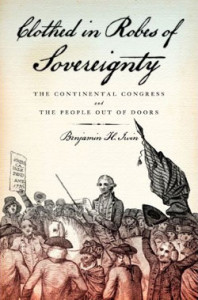The Continental Congress has received scant attention from the academic community in recent decades. The scholarly zeitgeist tends to portrays its members as perpetually frozen in John Trumbull’s painting of the moment they declared independence, carrying out a famous act that everyone recognizes. But this image has little connection to the social and cultural history that has enriched our understanding of the lives of the men and women who experienced the beginning of the United States. While millions from around the world queue up for the chance for a few moments in the room where the Continental Congressmen performed their most significant work, scholars have seen their story as self evident, and turned attention to other groups—pamphlet writers in scattered towns, the crowds that gathered on Pennsylvania’s State House lawn, the men and women who met at colonial taverns and coffeehouses, the men who enlisted as soldiers in the army the Congress created, and the individuals and groups who lived through the revolution: white and black, men and women, rich and poor.
Benjamin Irvin has resuscitated the Continental Congress in light of recent historiographical method, capturing the way it crafted and then used its own authority, the methods it took to draw an American imagination into supporting a newborn American national cause, and finally, how it lost that authority amidst a failing economy and increasing success by other people who carried out this nationalizing mission better.
As Irvin breathes life into the group, they are meeting in Philadelphia, seeking redress from the government in London for oppressive policies of taxation and military action. Those tales are oft-told, but where Irvin’s book moves into new territory, and where the great benefit of this excellent study of politics and culture establishes itself, is showing the ways that the colonial leadership strove to build on earlier means of authority while at the same time breaking with both the empire and earlier customs. The effort was both tricky and dangerous, the author relates. Immediately upon gathering, congressmen used manners, possessions, and customs of entertainment to show one another and the people of the city around them that they deserved their new level of authority. In their clothing, style of meeting, attendants, and entertainments, they revealed patterns of refinement and gentility. Irvin’s work dovetails nicely into earlier, seminal works by Richard Bushman and T.H. Breen that explained the meaning of these patterns, and adds to that historiography by showing the ways those characteristics came into question as Congress sought ways to protest the king’s ministers’ actions. “The Continental Congress worked concertedly to supplant the tokens and habits of the British nation with fresh ones devoted to the United States. It implemented codes of conduct by which patriotic Americans could distinguish those who belonged to their imagined community from those who did not” (10).
By proscribing the rich entertainments that all social ranks had been using for years to establish their position or ambition as Britons, Congress sought to impose frugality and economic restraint as a means to unite a divergent people. Irvin’s book shows that actually carrying out this sea change of political behavior could be a double-edged sword. Congress created the Articles of Association to draw the people to its cause. Closing theaters and puppet shows, stripping funerals of their lavish display and opulent gifting, and calling on hostesses and hosts to refrain from sumptuous meals all allowed the colonists to join in a shared sacrifice of war. But when Congress itself attempted to underpin its authority in entertainments like a proposed grand ball for Martha Washington, the people’s displeasure became palpable. Even as it called for an end to public dances, Congress found itself in a very complex minuet with the people of the new nation’s largest city, a people willing to use old methods to enforce a new nation’s rules.



















